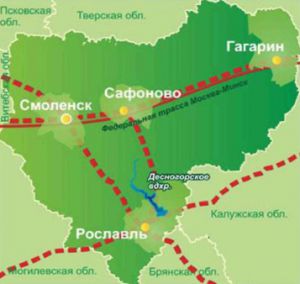- Main
- Smolensk region
- Geopolitical location and raw material base
Geopolitical location and raw material base
 Smolensk region is situated in the center of East European plain, on the western border of the Russian Federation. The region is a part of the Central federal okrug of the Russian Federation and according to the economic zones grid belongs to the Central economic area.
Smolensk region is situated in the center of East European plain, on the western border of the Russian Federation. The region is a part of the Central federal okrug of the Russian Federation and according to the economic zones grid belongs to the Central economic area.
The area of Smolensk region in modern borders is 49.8 thousands square km, which is about 0.3% of the total area of Russia. The length of the territory from west to east is 280 km, from north to south it is 250 km. The administrative-territorial entities include 25 administrative districts and 2 cities of regional control: center of the region – Smolensk (318.0 thousands people) and Desnogorsk (31.9 thousands people). The largest cities of Smolensk region are: Vyazma (55.95 thousands people), Gagarin (27.7 thousands people), Roslavl (54.3 thousands people), Safonovo (45.3 thousands people), Yartsevo (50.9 housands people), Dorogobuzh (11.7 thousands people). The urban settlements include 15 industrial communities. The largest of them are Verkhnedneprovsky and Ozerny.
Smolensk region borders five regions of Russia: to the north – Pskov region and Tver region, to the east and south-east – Moscow and Kaluga regions, to the south – Bryansk region, and two regions of Republic of Belarus – Vitebsk region to the north-west and Mogilev region to the south-west. The length of the state border is about 1/3 of the entire perimeter, crossed by more than a hundred and a half of different types of roads. Smolensk region is a very important transportation and communication center. The following routes go through it:
- the shortest automobile roads and railways linking Western Europe with Central Russia (including the Moscow-Minsk highway);
- a lateral motor transport corridor “St. Petersburg – South of Russia”, essential for the country;
- one of the largest gas pipelines “Yamal – Europe”;
- high voltage power line “Russia – Belarus – Western Europe”;
- world fiber-optic telecommunication mains.
Being an area of exclusive geographic and political location and having the necessary territorial and material resources, as well as considerable technical and intellectual potential and a developed transportation and communication system, Smolensk region is one of the most favorable regions for developing logistic and terminal complexes.
The amount of foreign freight traffic going through the region is almost 2/3 of the entire Russian foreign freight turnover. The largest transportation junctions – Smolensk, Vyazma, Roslavl – have mighty warehouses with access ways and sorting stations. Beside the two country’s capitals, Moscow and St. Petersburg, Smolensk region is the only region where transportation and communication services can be provided in a complex on such level.
Administration considers the geographic location of the region and the forming infrastructure as one of the most important independent resources of the region’s development.
Lying in middle latitudes, in an area noticeably affected by Atlantic air masses, its territory is a water-parting of three large river systems of the European area of the country – Volga, Dnieper and West Dvina systems. These characteristics of the physical and geographic location determine the main features of the region’s nature: moderate continental climate, prevailing hills and minor rivers, wide-spread forests and sod-podzolic soils.
The climate is moderate continental. Summer is warm (average July temperature is 17-18 degrees Centigrade), winter is moderate cold (average January temperature is minus 8.5). Annual precipitation varies from 530 to 650 mm.
Mineral and raw material resources
Mineral resources play a significant role in the region’s economy, being the raw material base for the production of construction materials and road making. The leading position among the mineral resources belongs to brown coal, sand and gravel material, peat, fire clay, building stones, cement materials, bottom ooze, etc.
Structure of mineral and raw material resources of Smolensk region
building stones - 8,7%
carbonates - 3,5%
peat - 22,6%
ceramic raw materials - 3,8%
expanded clay raw materials - 0,7%
sand and gravel material - 25,6%
sand - 3,3%
tufaceous limestone - 0,4%
phosphorites - 0,6%
cement raw materials - 2,8%
brown coal - 26,7%
fire clays - 1,3%
The region’s mineral and raw material resources are also represented by fresh drinking and mineral underground water (52 fields) used for utility and drinking water supply.
